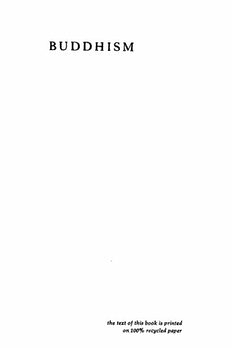
Buddhism: Its Essence and Development PDF
Preview Buddhism: Its Essence and Development
BUDDHISM the text of this book is printed on 100% recycled paper BUDDHISM Its Essence and Development by E C dward onze WITH A PREFACE BY ARTHUR WALEY HARPER TORCHBOOKS Harper & Row, Publishers New York, Hagerstown, San Francisco, London BUDDHISM : ITS ESSENCE AND DEVELOPMENT Printed in the United States of America Reprinted by arrangement with Bruno Cassirer Limited, Oxford, which published the original edition in 1951. First harper colophon edition published 1975. Library of Congress catalog card number: 59—10345 ISBN: 0-06-130058-6 79 80 20 19 CONTENTS PREFACE / by Arthur Waley INTRODUCTION Budhism as a Religion n Budhism as a Philosophy 15 Self-extinction 18 ‘ Radical Pessimism ’ 21 Immortality 23 Survival Value 25 COMMON GROUND The Flavour of Dharma 27 The Documents 28 The Buddha 34 Is Buddhism atheistic ? 38 The Four Holy Truths 43 Cosmology0 48 II MONASTIC BUDDHISM The Samgha 53 Poverty 54 Celibacy 58 Tnojfensiveness 61 Main Currents of Monastic Thought 66 III POPULAR BUDDHISM The Place of the Laity 70 The Temporal Power 72 The Services of the Samgha 77 The Influence of the Laity 85 IV THE OLD WISDOM SCHOOL Sects 89 Sariputra Arhats 93 Practices 95 Moral Discipline Trance 99 Wisdom Decline THE MAHAYANA, AND THE NEW WISDOM SCHOOL The Mahasanghikas 119 Hinayana and Mahayana 121 Literary Development 123 Bodhisattvas 125 Emptiness 13° Salvation 135 Parallels 140 VI BUDDHISM OF FAITH AND DEVOTION The Reception of Bhakti 144 Literary History 146 The Agent of Salvation 147 The Aims of the Faithful 152 Methods 157 Self-extinction and Faith 159 VII THE YOGACARINS Wisdom and Trance 161 Literary History 163 “ Mind-only ” 166 “ Store-consciousness ” 168 Further Doctrines 171 VIII THE TANTRA, OR MAGICAL BUDDHISM The Problem of the Tantra 174 History of the Tantra 176 Tantric Practices, 180 Tantric Philosophy 188 Tantric Mythology 189 Left-handed Tantra 191 The Control of the Body 197 IX NON-INDIAN DEVELOPMENTS Survey 200 Ch* an 201 Amidism 205 Rnyin-ma-pa 207 European Buddhism 210 APPENDICES TABLE OF DATES DIAGRAM New Wisdom School, Togacarins, Tantra PREFACE by ARTHUR V7ALEY ✓ HERE is not at present in English or any other T language so comprehensive and at the same time so easy and readable an account of Buddhism as is to be found in Dr. Conze’s book. You probably know the story of the king who asked the blind men what an elephant was like. One, feeling its trunk, said ‘ Like a chariot-shaft ’ ; another, feeling its ear, said 4 Like a winnowing-fan ’, and so on. The parable might well be applied to European attempts to write the history of Buddhism. Not that the historians were to blame. Early in the 19th century the only accessible documents were those representing medieval Buddhism in Nepal. So great was the sensation created by the subsequent recovery of a much earlier Canon in Ceylon that the Pali scriptures (those found in Ceylon) were taken as embodying the whole of early Buddhism. Even as recently as 1932 Mrs. Rhys Davids, in her Manual of Buddhism for Advanced Students (a rather ambitious title) makes little use of anything but the Pali scriptures. A year later a more comprehensive account was given by E. J. Thomas in his History of Buddhist Thought ; but his work is addressed to specialists rather than to the general public. Other books, such as Keith’s Buddhist Philosophy, are simply lists of views held by people felt to be wholly remote and “ lacking in both system and maturity.” To Dr. Conze the questions that Buddhism asks and answers are actual, living, questions, and he con stantly brings them into relation both with history and with current actuality. Books are, to my mind, valueless unless they express a point of view, and they must do this not by distorting the facts, but by making apparent to the reader the Author’s emotional and intellectual reaction to these facts. Dr. Conze’s book, more than any of its kind that I have read for a long time, succeeds in doing this. AUTHOR’S NOTE HE idea of this book originated with friends of T mine in 1941, when I lived in Godshill in Hampshire, and attempted to find out how much of Buddhist meditation could actually be practised in this present age. The first chapters represent lectures which I gave some years ago in Oxford at St. Peter’s Hall, and some traces of the spoken word still cling to them. In 1948, Dr. William Cohn, of Oxford, suggested to me that a work covering the whole range of Buddhist thought would be much appreciated, and encouraged me to complete the book. Dr. Cohn, and, at a later stage, Mr. Arthur Waley and Mr. Christmas Humpheys, have eliminated many errors. Mr. Claud Sutton and Mr. Arthur Southgate have watched over the English style. Discussions with various scholars have, I hope, put me right on a number of diffi cult and controversial points. In this connection, I must mention, with gratitude, Prof. F. W. Thomas, Dr. E. J. Thomas, Prof. Murti of Colombo, Prof. Lamotte of Louvain, Prof. Demieville of Paris, Prof. Tucci of Rome, and Dr. Pott of Leyden. Many of the texts on which my account is based have never been translated into English. It may one day be possible to offer the reader a Selection from the main Documents of Buddhist thinking, which would substantiate much that is merely stated here. Saffron close, EDWARD CONZE E . welme January, 1951.
